The Common Vein Copyright 2008
Definition
Phases
Oral PhaseOnce the food or fluid is placed in the mouth and after it is chewed it is held in the oral cavity until the function of swallowing is initiated. The bolus is retained in the mouth by the apposition of the soft palate with the back of the tongue. There should be no leakage from the oral cavity into the valleculae or pyriform sinuses.
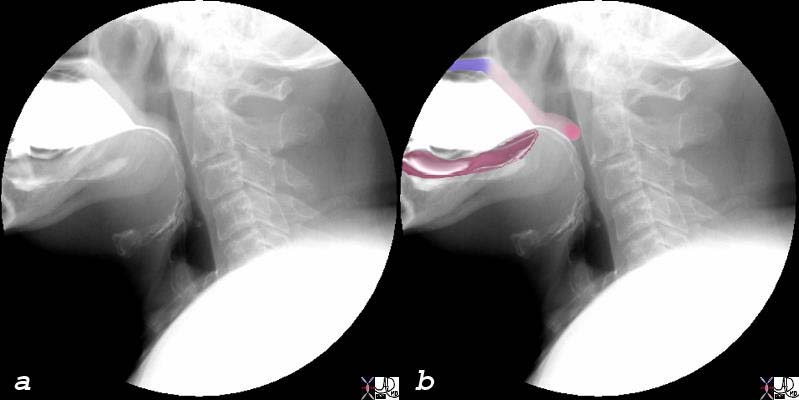 Bolus held in the mouthSoft Palate Apposed to the Tongue Bolus held in the mouthSoft Palate Apposed to the Tongue |
| 71476c02 mouth tongue soft palate barium swallow normal anatomy physiology function Courtesy Ashley Davidoff MD |
There are three basic parts to the pharynx; nasopharynx, oropharynx and hypopharynx. The food or fluid needs to be moved from the mouth to the oropharynx. Reflux of the bolus needs to be prevented from going up the nasopharynx and instead needs to be directed to the oropharynx.
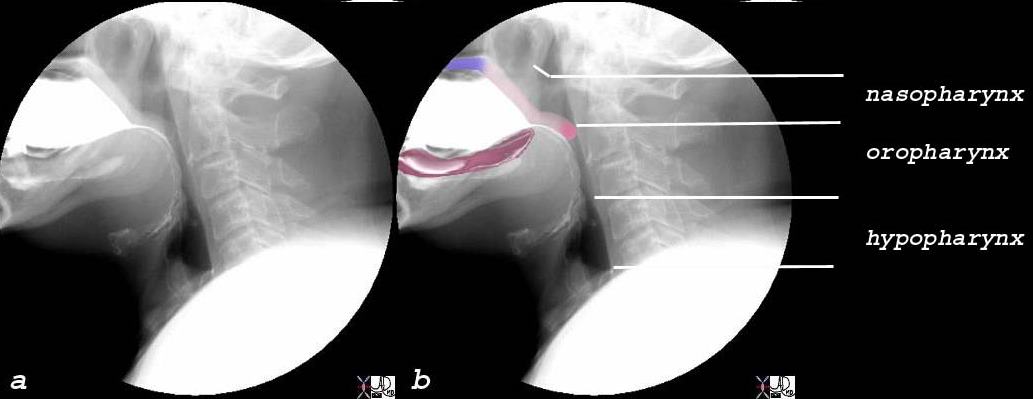 Parts of the Pharynx Parts of the Pharynx |
| 71476c03 mouth swallow oral phase blue = hard palate light pink = soft palate bright pink = uvula white = bolus in mouth maroon = tongue barium swallow oral phase minimal spillage nasopharynx oropharanx hypopharynx barium swallow Courtesy Ashley Davidoff MD |
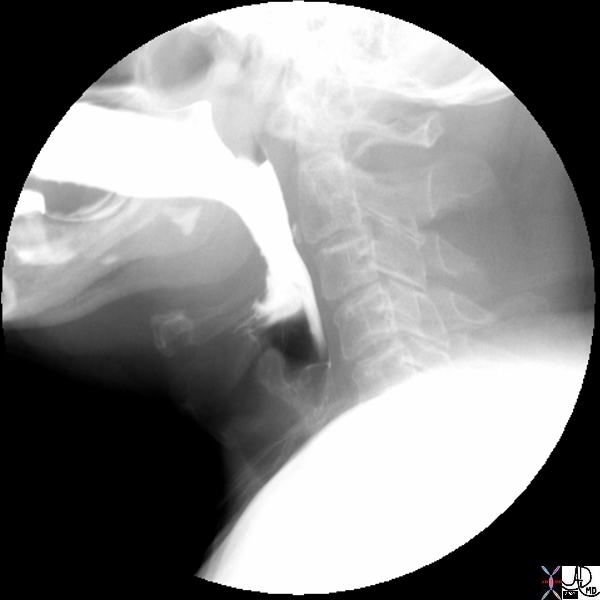 Initiation of the Swallow Soft Palate Elevates opening the Oropharynx Initiation of the Swallow Soft Palate Elevates opening the Oropharynx |
| 71476 mouth tongue soft palate barium swallow normal anatomy physiology function Courtesy Ashley Davidoff MD |
Once the swallow is initiated the bolus is moved from the mouth to the posterior oropharynx. The tongue pushes the bolus into the oropharynx. A peristaltic wave then propels the bolus controlled by the cerebral cortex and medulla. The soft palate moves upward preventing the bolus from entering the nasopharynx and the bolus is directed to the oropharynx and then hypopharynx by the tongue and directed by pharyngeal muscles The soft palate elevates, the superior constrictors converge on the soft palate, the soft palate is pushed against the posterior wall of the naopharynx and forms an “L” on its side. Food and fluid pass into the oropharynx and reflux of the bolus is prevented from refluxing into the nasopharynx. The bolus proceeds rapidly at about 12-25cms/second.
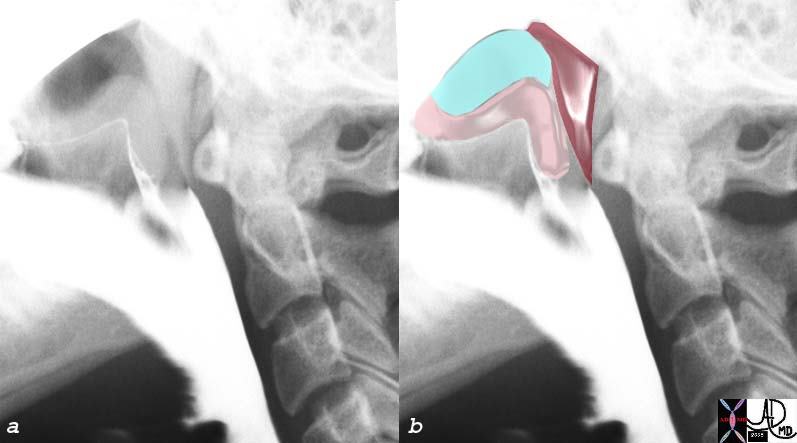 Soft Palate and Superior Constrictors Act as A Valve to Prevent Reflux of Bolus up Nasopharynx Soft Palate and Superior Constrictors Act as A Valve to Prevent Reflux of Bolus up Nasopharynx |
| 75239c01 teal = nasopharynx pink = soft palate maroon = superior constrictors soft palate nasopharynx oropharynx anatomy function physiology normal elevation of the soft palate The soft palate elevates, the superior constrictors converge on the soft palate, and food and fluid pass into the oropharynx minimal reflux up nasopharynx prevented from advancing into upper nasopharynx by soft palate and superior constrictors barium swallow normal Courtesy Ashley Davidoff MD |
Bolus in Oropharynx
The bolus has to be directed toward the esophagus and away from the airway. The latter is accomplished by the elevation and backward tilting of the epiglottis. The larynx elevates and tilts the epiglottis horizontally. The thyroepiglottic muscles contract and tilt the epiglottis backward. In so doing the vestibule above the vocal cords are closed and the airway becomes sealed. The bolus passes into the hypopharynx.
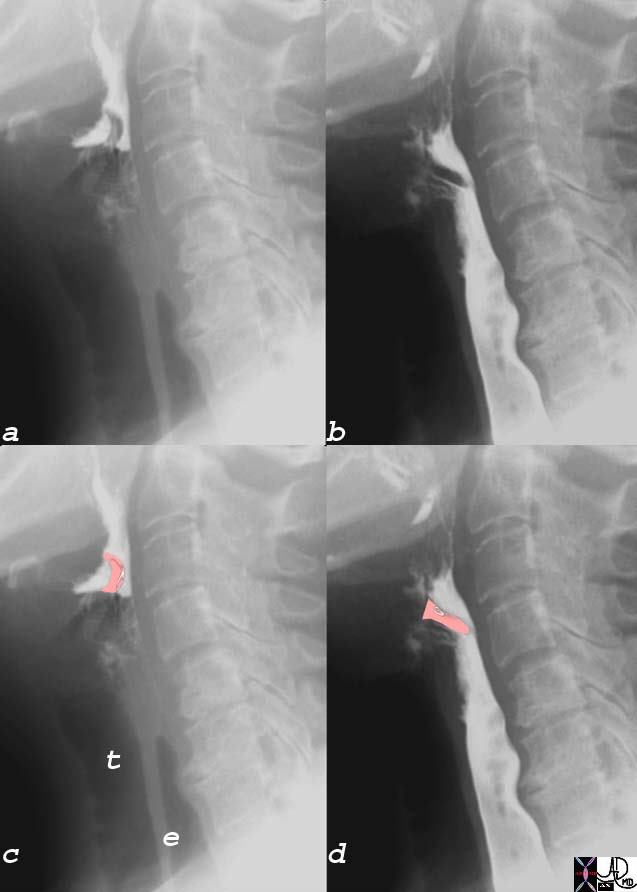 Function of the Epiglottis in Swallowing Function of the Epiglottis in Swallowing |
| During the second phase once the bolus leaves the mouth, the epiglottis tilts back first caused by the elevation of the larynx (epiglottis becomes horizontal) and secondly by the active contraction of the thyroepiglottic muscle. (epiglottis flips back) This causes the laryngeal aditus to beprotected and the food bolus is directed into the pyriforma sinuses and vallecullae and then down the esophagus.76182c01 epiglottis trachea esophagus osteophytes barium swallow cervical esophagus normal anatomy Courtesy Ashley Davidoff MD |
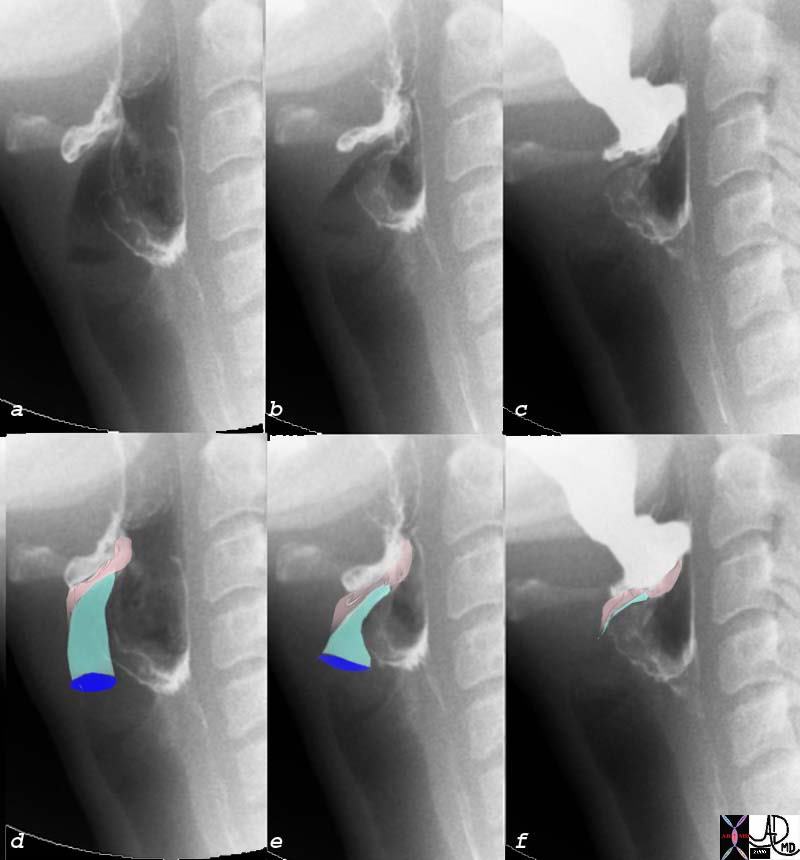 Obliteration of the Vestibule and Ventricle Obliteration of the Vestibule and Ventricle |
| 76195c04 pharynx hyoid bone oropharynx epiglottis vallecula pyriform sinus laryngeal ventricle obliteration of the ventricle during swallow obliteration of the vestible during swallow vocal cord trachea esophagus hypopharynx normal anatomy Courtesy Ashley Davidoff MD |
Bolus in HypopharynxThe bolus in the hypoharynx causes the UES to open and the bolus passes into the proximal esophagus, and the primary srtripping wave is initiated. The UES is also called the cricopharyngeal sphincter because it is formed mainly by the cricopharyngeus muscle.The bolus in the hypopharynx causes the UES to open and the bolus passes into the proximal esophagus, and the primary stripping wave is initiated. The UES is also called the cricopharyngeal sphincter because it is formed mainly by the cricopharyngeus muscle.Regardless of the size of the food bolus being swallowed, the UES muscle fibers relax the same amount. In other words, if one were to measure the muscle tonicity during the swallow of a sip of water versus a large piece of steak, they would be equal. However, the diameter that the region opens to is related to the bolus size. So that same piece of steak would cause the UES to open, or stretch, to a greater degree than the sip of water.The UES relaxes 0.1 seconds before the sphincter actually opens to allow for the bolus to pass. This shows the importance of proper efferent and afferent cooperation. Once the bolus has passed, the UES closes and the posterior pharyngeal constrictor muscles contract. This provides a high pressure in the hypopharynx, with a lower pressure in the esophagus. Once the bolus passes through the circipharngeus muscle, the esophageal phase has begun. The esopageal longitudinal muscles contract causing an overall shortening of the esophagus by 2-2.5cm. Soon after this longitudinal muscle contraction, the circular muscles contract forcing the bolus more distally. Hence, the peristaltic wave that was initiated in the oropharyngeal phase continues to propel down the esophagus. This is known as a primary peristaltic wave. Normal ranges for primarycontraction pressures range from 30-120mmHg. It is a rapid contraction, with the peak strength reached in approximately 1 second. Relaxation of the muscles needs to be just as rapid so the bolus can continue passing smoothly in a uniform direction. The bolus should travel with the primary peristaltic wave at a rate of 2-4cm/second.
If, however, the esophagus is not completely emptied of the bolus, the efferent vagal nerves that arise in the medulla sense this distension and cause another peristaltic wave. This wave is known as secondary peristalsis. It is completely an involuntary process.
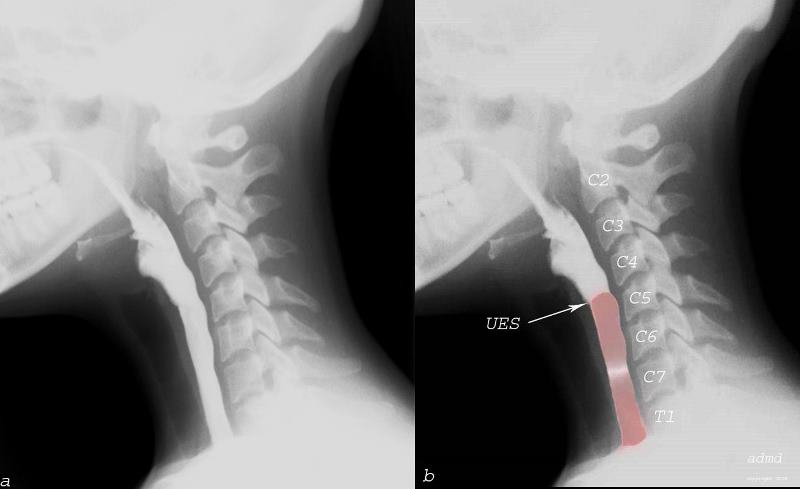 Upper Esophageal Sphincter Upper Esophageal Sphincter |
| 75010c01 esophagus pharynx cervical esophagus upper esophageal sphincter UES normal anatomy retropharyngeal air dx idiopathic perforation possibly due to straining carrying a heavy bag Barium Swallow Courtesy Ashley Davidoff MD |
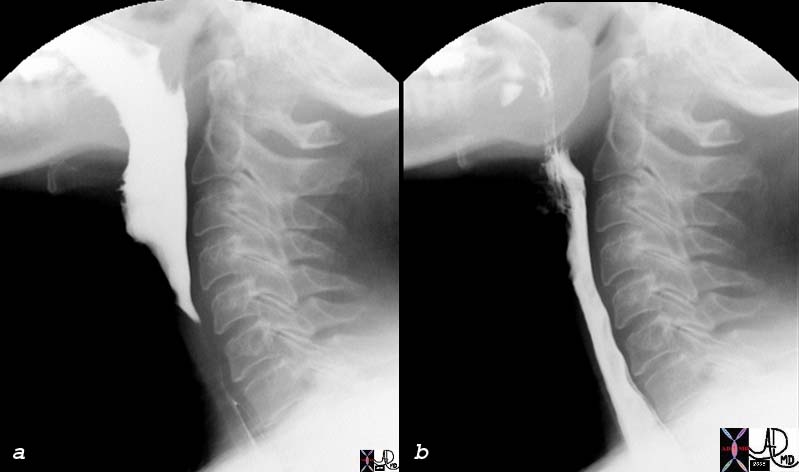 UES Closed and then UES Open UES Closed and then UES Open |
| 76354c esophagus swallow esophagus swallow UES closed upper esophageal sphincter UES open pharyngeal phase normal swallowing physiology Courtesy Ashley Davidoff MD |
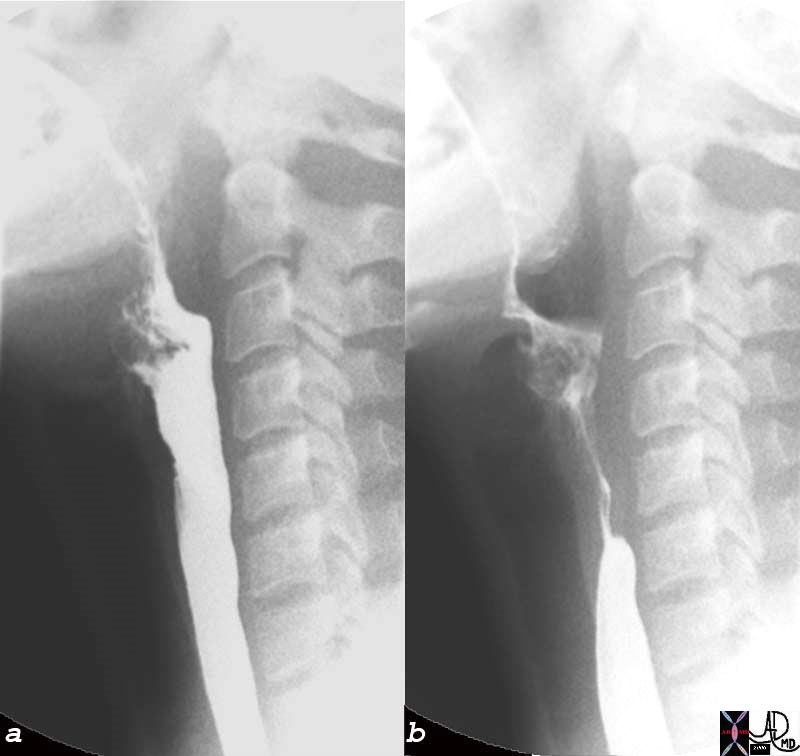 Upper Esophageal Spincter Open, (a) Closed (b) and beginning of Primary Stripping Wave Upper Esophageal Spincter Open, (a) Closed (b) and beginning of Primary Stripping Wave |
| 76204c esophagus cervical esophagus UES upper esophageal sphincter beginning of primary stripping wave normal physiology swallowing mechanism function single contrast barium swallow Courtesy Ashley Davidoff MD |
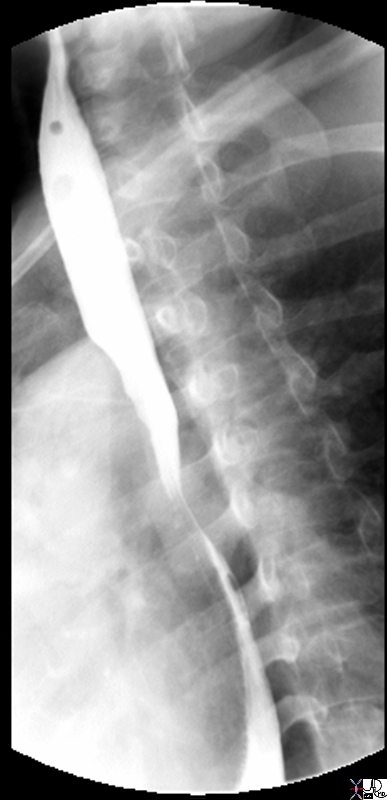 Primary Stripping Wave in Mid Esophagus Primary Stripping Wave in Mid Esophagus |
| 76199 esophagus swallowing normal anatomy physiology function shape muscle contraction relaxation single contrast barium swallow Courtesy Ashley Davidoff MD |
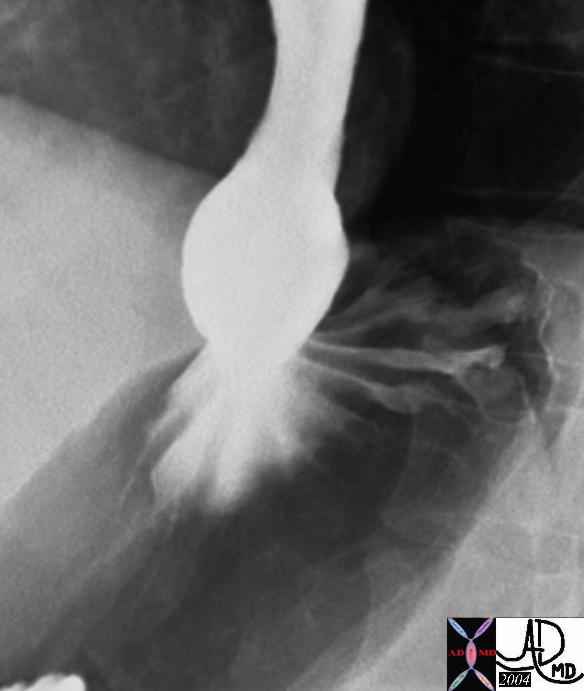 GE Junction Relaxes and Allows Bolus to Pass GE Junction Relaxes and Allows Bolus to Pass |
| 32531 esophagus epiphrenic ampulla stomach GE junction gastroesophageal junction normal anatomy 5star upper GI UGI contrast barium X-Ray imaging radiology barium swallow |
The bolus then reaches the distal esophagus and passes through the LES which typically relaxes, and therefore opens, approximately 2 seconds after a swallow is initiated.There is a unique inhibitory process within the esophagus, known as “deglutive inhibition.” This is the rapid and complete inhibition of a second peristaltic process if the previous peristaltic wave hasn’t been completed. It results from hyper-polarization of the neurons of the myenteric plexus innervating the smooth muscles responsible for peristalsis. This, along with the above discussed efferent/afferent signaling, allows for unidimensional passage of a food bolus to the stomach for digestion.Applied BiologyPenetration
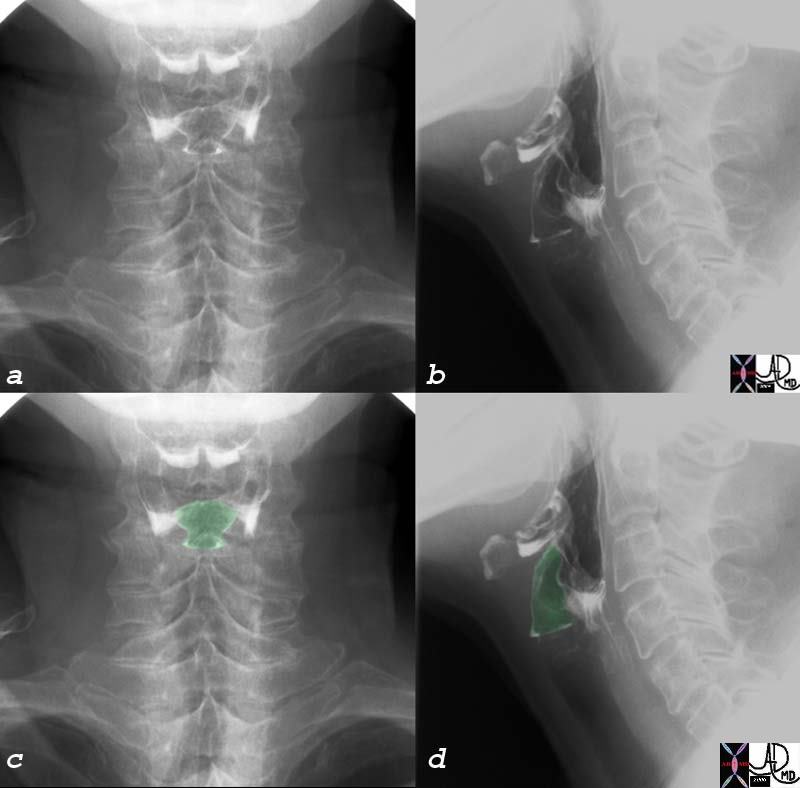 Penetration into the Vestibule Penetration into the Vestibule |
| 76210c swallow penetration laryngeal vestibule hypopharynx barium swallow Courtesy Ashley Davidoff MD |
AspirationAspiration is the passage of food or liquid through the vocal folds. Small amounts may ne normally aspirated and automatically induce a cough. (“food went down the wrong way”) Large amounts of aspiration are abnormal and predispose to pneumonia.
 Aspiration Aspiration |
| 46508c01.800 esophagus dysphagia fx large osteophyte causing difficulty with passing a scope fx aspiration barium swallow x-ray contrast Davidoff MD |
Bolus held in the mouthSoft Palate Apposed to the Tongue
Parts of the Pharynx
Initiation of the Swallow Soft Palate Elevates opening the Oropharynx
Soft Palate and Superior Constrictors Act as A Valve to Prevent Reflux of Bolus up Nasopharynx
Function of the Epiglottis in Swallowing
Obliteration of the Vestibule and Ventricle
Upper Esophageal Sphincter
UES Closed and then UES Open
Upper Esophageal Spincter Open, (a) Closed (b) and beginning of Primary Stripping Wave
Primary Stripping Wave in Mid Esophagus
GE Junction Relaxes and Allows Bolus to Pass
Penetration into the Vestibule
Aspiration
